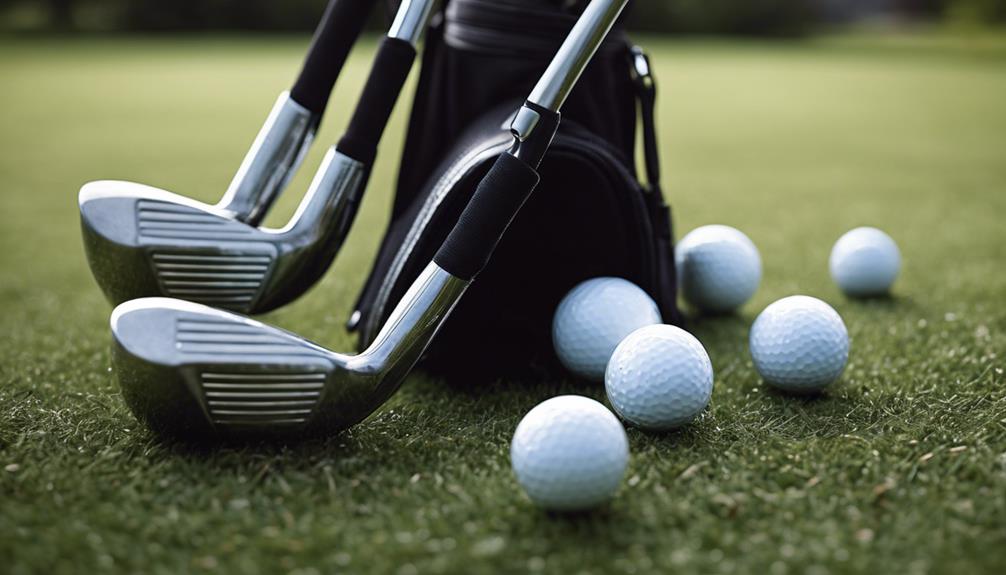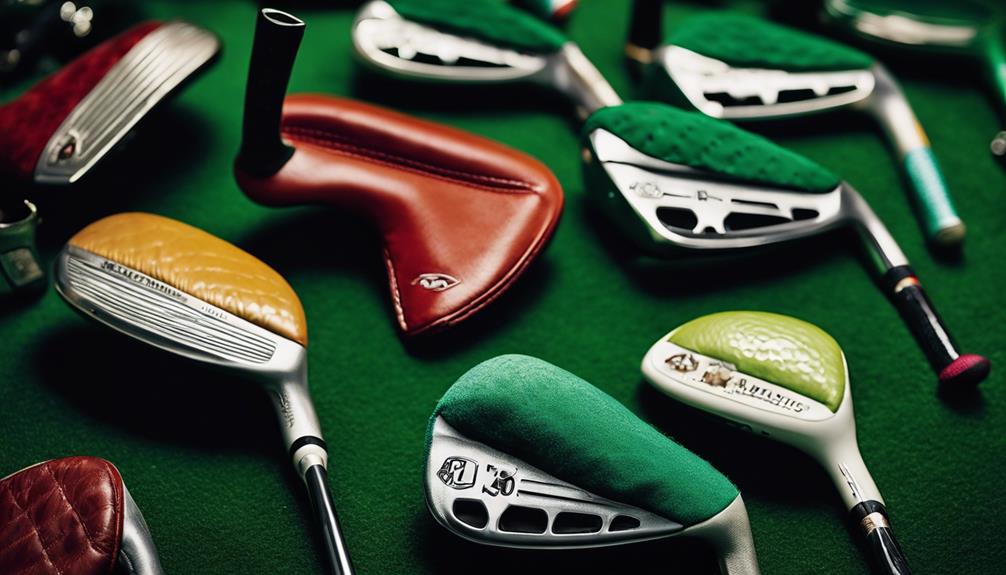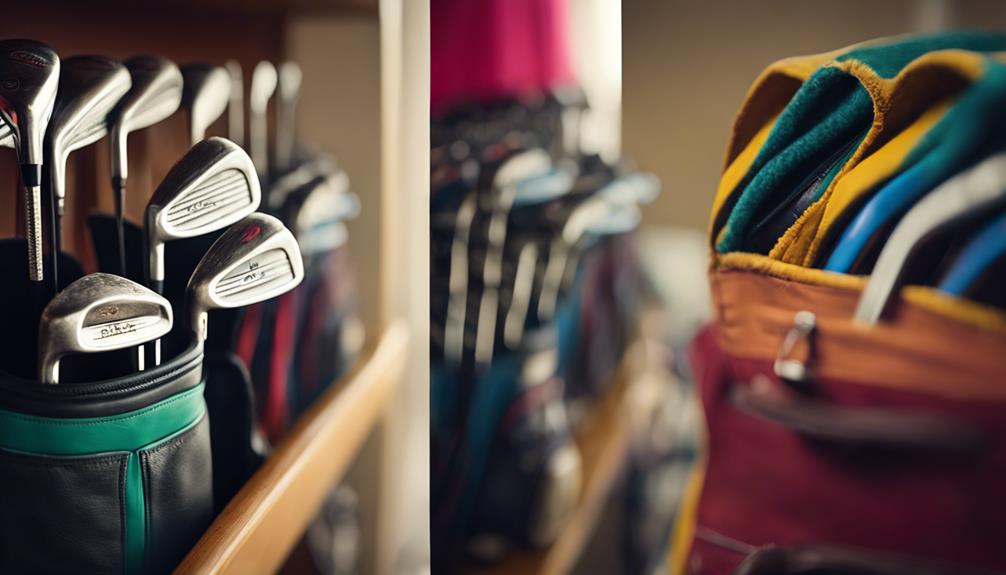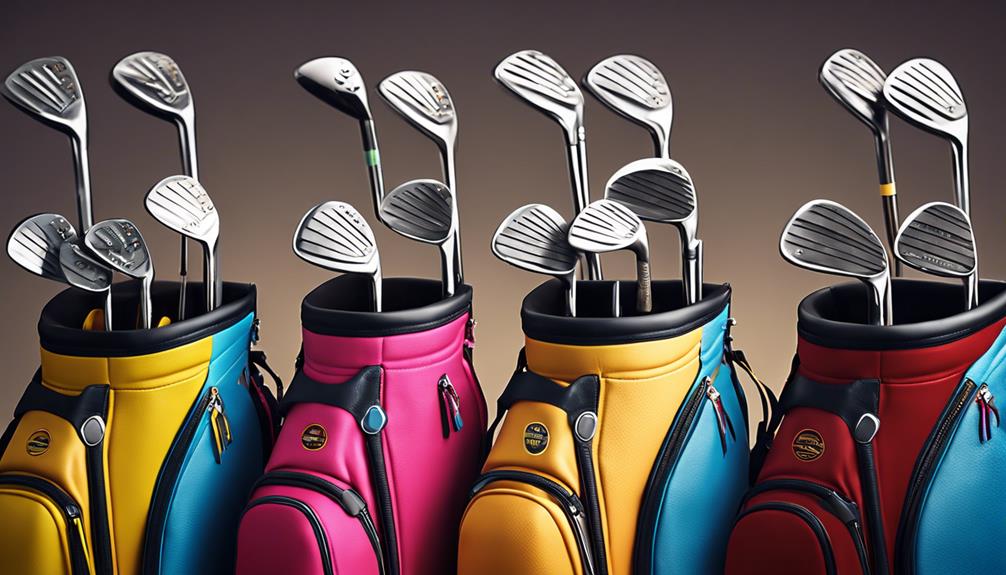- 7 Top Flite Golf Clubs XL for Improved Performance - September 28, 2024
- Top Flite Golf Clubs: Top 5 Reasons to Choose Them - September 28, 2024
- Top 3 Golf Club Fitters for a Perfect Swing - September 28, 2024
You're likely wondering if golf clubs have covers, and the answer is yes. Golf club headcovers serve as protective barriers against damage and environmental elements, safeguarding your investment from dirt, debris, and impact damage. They also minimize noise during transport, making your golfing experience more enjoyable. Headcovers come in various materials and designs tailored to specific club types, and they can even aid in club identification. By using headcovers, you can extend the lifespan of your clubs, maintain their resale value, and enhance your overall golfing experience. As you explore the world of golf, you'll soon discover the importance of these covers in protecting your gear.
Key Takeaways
- Yes, golf clubs have covers called headcovers that protect them from damage and environmental elements.
- Headcovers are designed to fit specific club types, such as drivers, fairway woods, hybrids, and putters.
- They serve purposes beyond protection, including noise reduction, club identification, and personalization.
- Not all clubs require headcovers, but drivers, fairway woods, hybrids, and putters are the most vulnerable and benefit from protection.
Understanding Golf Club Headcovers
As you explore the world of golf, it's essential to understand that golf club headcovers serve as an important accessory, providing a protective barrier against damage and environmental elements that can compromise the performance of your clubs.
You need head covers to shield your clubs from scratches, dings, and harsh weather conditions when not in use. Made from durable materials like polyurethane faux leather and lined with soft fabrics, golf head covers guarantee your clubs remain in peak condition.
Each headcover is tailored to specific club types, such as drivers, fairway woods, hybrids, and putters, due to the varying shapes and sizes of the clubs.
The benefits of head covers extend beyond protection; they also minimize noise from clanging during transport, enhancing the overall golfing experience. Properly fitting headcovers aid in club identification, making it easier to locate specific clubs within your golf bag.
Purpose of Golf Headcovers
With your golf clubs properly fitted with headcovers, you can now explore the primary purpose of these protective accessories, which is to safeguard your valuable clubs from various forms of damage and wear.
Headcovers serve a vital function in protecting your clubs from dirt, debris, and impact damage, which is essential for maintaining their value and longevity. Covers offer protection to your most vulnerable clubs, such as drivers, fairway woods, hybrids, and putters, which are prone to scratches and dings.
By using headcovers, you can protect your clubs and reap the benefits of golf, including improved performance and extended club lifespan.
In addition, headcovers help minimize noise during transport, reducing the risk of damage caused by clanging clubs. They also provide aesthetic appeal, allowing you to express your personal style on the course.
Moreover, customization options enable easy club identification, keeping your golf bag organized and making it easier to locate specific clubs.
Protecting Your Club Investment

When it comes to protecting your club investment, you need to prioritize essential protection measures to guarantee your clubs remain in top condition.
You'll want to focus on preventing damage from transport, environmental elements, and impacts with other clubs in your bag, as even minor scratches can greatly impact resale value.
Club Protection Essentials
You invest a significant amount of money in your golf clubs, so it's vital to protect them from damage and wear to guarantee they continue to perform at their best and retain their resale value. One of the most essential protection measures is using club head covers. These covers shield your clubs from scratches, dings, and environmental damage, ensuring they remain in top condition.
Here's a breakdown of the benefits of using club head covers:
| Benefit | Description | Importance |
|---|---|---|
| Protects from impact damage | Prevents scratches and dings on club heads | High |
| Maintains resale value | Preserves club condition to command higher prices | Medium-High |
| Reduces noise during transport | Minimizes clanging and enhances overall golfing experience | Medium |
| Provides additional protection for graphite shafts | Protects shafts from moisture and impacts | High |
Club Damage Prevention
By recognizing the importance of club protection, golfers can take proactive steps to prevent damage and extend the lifespan of their investment, guaranteeing peak performance and preserving resale value.
You can protect your golf clubs from impacts and environmental elements by using headcovers, which greatly reduce the risk of scratches, dings, and wear. Longer neck headcovers provide additional protection for graphite shafts, guarding against moisture and impacts that can lead to costly repairs or replacements.
Many professional golfers prioritize headcover use for their key clubs, such as drivers and putters, underscoring the importance of protecting high-value equipment. Investing in quality headcovers is a cost-effective measure compared to the potential expenses of replacing damaged clubs, thereby safeguarding your overall golfing investment.
Essential Clubs to Cover
The most vulnerable clubs in your golf bag, including drivers, fairway woods, hybrids, and putters, require protective covers to safeguard against damage and wear.
You'll want to prioritize covering your drivers, as they're often the most expensive and susceptible to damage from impacts and environmental elements.
Fairway woods also need covers to protect against scratches and dings, given their lightweight construction.
Hybrids, which combine features of woods and irons, benefit from head covers to prevent scratches and damage.
While putters are often covered for added protection and style, they're also valuable clubs that benefit from safeguarding against wear and tear.
You mightn't need to cover your irons, as they're generally durable, but if you want added protection and organization, iron covers can be a good option.
Choosing the Right Headcover

With your most vulnerable clubs identified, it's time to select the right headcovers to safeguard them, taking into account factors such as material, size, and style to guarantee a perfect fit.
You'll want to choose to use headcovers that provide adequate protection for your drivers, fairway woods, and hybrids, as these clubs are more prone to damage.
When selecting headcovers, you'll find a variety of materials to contemplate. Leather offers durability and a classic look, while synthetic options provide ease of cleaning and a range of design options.
Verify the size of the headcovers fits your specific clubs; improper sizing can lead to inadequate protection or difficulty in putting on and removing the covers.
You can also evaluate the style of headcovers available, from bright patterns to classic colors, to reflect your personal taste and add personality to your golf gear.
Some golf club sets come with matching headcovers, simplifying the purchasing process and ensuring a cohesive look for your equipment.
Benefits of Using Headcovers
Protecting your golf clubs from damage and wear is essential, and using headcovers achieves this while offering several additional benefits that enhance your overall golfing experience.
By using headcovers, you'll extend the lifespan of your clubs and maintain their resale value. You'll also minimize the noise from clubs clanking together during transport, reducing the risk of damage and making your golfing experience more enjoyable.
Golf clubs need covers for protection, and headcovers deliver. They keep your clubs clean and dry, ensuring peak performance during play. Plus, with distinct colors and designs, you'll quickly identify the right club, saving time and reducing frustration.
Using headcovers even allows for personalization, enabling you to express your individuality and style on the course. To keep your clubs in top condition, invest in high-quality headcovers that provide the protection and benefits you need.
Common Misconceptions Debunked

As you explore the world of golf, it's important to separate fact from fiction, and understanding what headcovers can and can't do is essential to getting the most out of your game. One common misconception is that all clubs require head covers, but in reality, only specific clubs like drivers, fairway woods, hybrids, and putters benefit considerably from protection.
Here are some misconceptions debunked:
- Not all clubs need head covers; irons are generally durable and don't require protection.
- Using iron covers can actually be a sign of inexperience, as they can trap moisture and lead to rust.
- Head covers offer more than just an aesthetic appeal; they protect clubs from scratches, dings, and environmental elements that could affect performance and longevity.
- Failing to use head covers can leave your clubs susceptible to damage, decreasing their resale value.
Golf Club Headcover Etiquette
When it comes to golf club headcover etiquette, you'll find that consistently using them on your drivers and fairway woods isn't only a sign of respect for your equipment but also a courtesy to your fellow players on the course.
By using headcovers, you're protecting your metal woods from scratches and dings that can affect their performance and resale value. It's especially important for these clubs, as they're more susceptible to damage and expensive to replace.
On the course, make certain your headcovers are securely fitted to prevent them from falling off and causing distractions or hazards for other players.
Using headcovers also enhances organization in your golf bag, allowing for quicker identification and access to specific clubs during play.
While personal preference plays a role, experienced golfers view headcover usage as a sign of care and respect for their equipment and fellow players.
Maximizing Headcover Functionality

As you focus on maximizing headcover functionality, you'll want to explore essential protection methods that safeguard your clubs from damage.
By utilizing the right headcovers, you can prevent scratches, dings, and wear, ensuring your clubs perform at their best.
Additionally, you can take advantage of customization options to express your personal style and quickly identify your clubs on the course.
Essential Protection Methods
Your golf clubs rely on their headcovers to shield them from the rigors of transportation and environmental exposure, making it crucial to maximize their protective functionality. By using headcovers, you can help keep your clubs in pristine condition, guaranteeing they perform at their best throughout their lifespan.
Here are some essential protection methods to take into account:
- Use headcovers to shield clubs from physical impacts, scratches, and dings, thereby prolonging their lifespan.
- Opt for longer neck headcovers to provide added protection for graphite shafts, reducing the risk of damage during transport and from moisture exposure.
- Select quality headcovers that help maintain the integrity of painted finishes, preventing chipping and wear.
- Take advantage of headcovers to minimize the clanging noise from clubs during transport, which can lead to potential damage and guarantees a more pleasant golfing experience.
Customization Options
You can elevate the functionality of your golf club headcovers by exploring customization options that cater to your unique preferences and needs.
With custom golf club headcovers, you can choose from a range of materials, such as leather or synthetic options, depending on your priorities for durability and maintenance.
Many brands offer personalized designs, allowing you to showcase your style through custom colors, patterns, and logos on your headcovers.
These customization options not only enhance the aesthetic appeal of your headcovers but also provide additional functionalities, such as magnetic closures or extended necks, which offer convenience and enhanced protection for your club shafts.
You can also find themed or novelty headcovers that reflect your personal interests or favorite sports teams, adding a touch of personality to your golf bag while maintaining club protection.
Frequently Asked Questions
Do Clubs Come With Covers?
When you purchase a new club, you'll find that some come with covers, while others don't, depending on the brand and model; check the packaging options to verify you get the cover material type that provides ideal club protection benefits.
Why Do People Put Covers on Their Clubs?
As you slip on those stylish head covers, you're not just accessorizing – you're safeguarding your valuable clubs from damage, preserving their performance, and showcasing your personal style, all while reaping the benefits of club protection, aesthetics, and maintained value.
Do Tour Pros Use Iron Covers?
You'll rarely find tour pros using iron covers, as they prioritize quick access and club maintenance over added iron protection, citing minimal performance impact and adhering to professional preferences for a streamlined, high-performance setup.
Do You Need a Travel Cover for Golf Clubs?
Like a fragile egg in a carton, your golf clubs need protection during travel. You need a travel cover for golf clubs to reap benefits like airline damage protection, secure storage, and convenient transport, especially when choosing travel bags that fit your clubs snugly.
Conclusion
As you slip your clubs back into their protective cocoons, remember that headcovers are the guardians of your golfing arsenal.
They shield your prized possessions from the harsh realities of the course, just as a wise mentor shields a novice from the pitfalls of inexperience.
By embracing the humble headcover, you guarantee your clubs remain as sharp as your game, ready to strike when opportunity arises.




